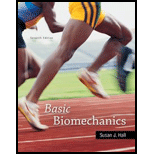
Basic Biomechanics
7th Edition
ISBN: 9780073522760
Author: Susan J Hall
Publisher: McGraw-Hill Education
expand_more
expand_more
format_list_bulleted
Textbook Question
Chapter 1, Problem 5AP
The hypotenuse of right triangle ABC (shown here) is 4 cm long. What are the lengths of the other two sides? (Answer: A = 2 cm; B = 3.5 cm)
Expert Solution & Answer
Want to see the full answer?
Check out a sample textbook solution
Chapter 1 Solutions
Basic Biomechanics
Ch. 1 - Write a brief discussion about how knowledge of...Ch. 1 - Prob. 4IPCh. 1 - Write a summary list of the problem-solving steps...Ch. 1 - Prob. 6IPCh. 1 - Step by step, show how to arrive at a solution to...Ch. 1 - Solve for x in each of the equations below. Refer...Ch. 1 - Two schoolchildren race across a playground for a...Ch. 1 - A 0.5 kg ball is kicked with a force of 40 N. What...Ch. 1 - When attempting to balance your checkbook, you...Ch. 1 - Prob. 3AP
Ch. 1 - Wendell invests 10,000 in a stock portfolio made...Ch. 1 - The hypotenuse of right triangle ABC (shown here)...Ch. 1 - In triangle DEF, side E is 4 cm long and side F is...Ch. 1 - An orienteer runs 300 m north and then 400 m to...Ch. 1 - Prob. 8APCh. 1 - Prob. 9APCh. 1 - A sailboat heads north at 3 m/s for 1 hour and...
Knowledge Booster
Learn more about
Need a deep-dive on the concept behind this application? Look no further. Learn more about this topic, bioengineering and related others by exploring similar questions and additional content below.Similar questions
- In which direction would an MRI scanner move to produce sequential images of the body in the frontal plane, and in which direction would an MRI scanner move to produce sequential images of the body in the sagittal plane?arrow_forwardDescribe the sequence of injuries that may occur if the extended, weight-bearing knee receives a very strong blow to the lateral side of the knee.arrow_forward
Recommended textbooks for you
- Surgical Tech For Surgical Tech Pos CareHealth & NutritionISBN:9781337648868Author:AssociationPublisher:Cengage
 Principles Of Radiographic Imaging: An Art And A ...Health & NutritionISBN:9781337711067Author:Richard R. Carlton, Arlene M. Adler, Vesna BalacPublisher:Cengage Learning
Principles Of Radiographic Imaging: An Art And A ...Health & NutritionISBN:9781337711067Author:Richard R. Carlton, Arlene M. Adler, Vesna BalacPublisher:Cengage Learning




Surgical Tech For Surgical Tech Pos Care
Health & Nutrition
ISBN:9781337648868
Author:Association
Publisher:Cengage


Principles Of Radiographic Imaging: An Art And A ...
Health & Nutrition
ISBN:9781337711067
Author:Richard R. Carlton, Arlene M. Adler, Vesna Balac
Publisher:Cengage Learning
The Skeletal System; Author: Professor Dave Explains;https://www.youtube.com/watch?v=f-FF7Qigd3U;License: Standard YouTube License, CC-BY